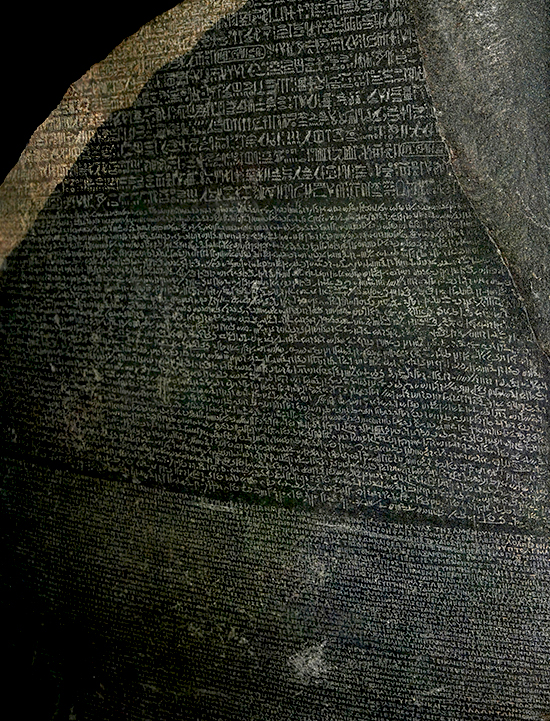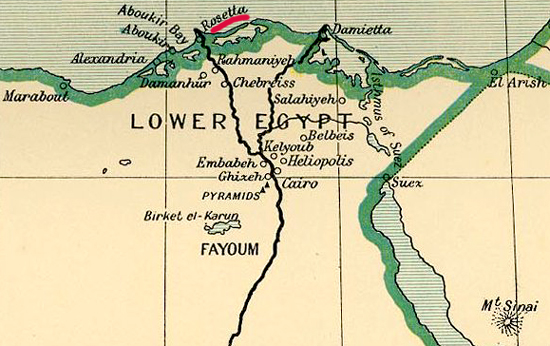|

the Rosetta Stone at the British Museum in London
Click picture to enlarge (really large)
Rosetta Stone
|
|
Image Above
The Rosetta
Stone has the following dimensions:
Height: 112.3 cm /
44.2 in
Width: 75.7 cm / 29.8 in
Thickness: 28.4 cm / 11.1 in |
Rosetta is a
town in Egypt.
In Arabic, the town's name is el-Rashid
or Rasheed.
Here is Rosetta on a map:

Map Location of Rosetta, Egypt in 1798
Click to enlarge
What's So Special
About the Rosetta Stone?
The Rosetta Stone carries an inscription
that is written three times in different languages
and scripts. This stone helped decipher the ancient Egyptian hieroglyphic script.
It
is the only surviving fragment of a larger stone slab (stela)
recording a decree on March 27, 196 BC, written by grateful Egyptian
priests at Memphis.
Ptolemy V
Epiphanes was the king of Egypt at the time. This
decree was written in the 9th year of his reign.
View Ptolemy V Epiphanes' entry in the
 List of Egyptian Rulers.
List of Egyptian Rulers.
The Writing on the
Rosetta Stone
At the top section, the decree was written in
Egyptian hieroglyphs,
the traditional or hieratic script of Egyptian monuments, already 3000 years
old.
In the middle, the same decree was
written in Egyptian demotic, the everyday script of literate Egyptians,
and a simplification of the traditional form.
At the bottom, the decree once more
but in Greek, the language
used by the administration.
(See picture at the top.)
What Does the
Inscription Say?
In a nutshell, it tells us that the
Egyptians should be very glad because their king is a great ruler, and how they are to honor him.
In detail, it says that Ptolemy V.
Epiphanes...
[...]
consecrated revenues of silver and corn to
the temples, that he suppressed certain
taxes and reduced others, that he granted
certain privileges to the priests and
soldiers, and that when, in the eighth year
of his reign, the Nile rose to a great
height and flooded all the plains, he
undertook, at great expense, the task of
damming it in and directing the overflow of
its waters into proper channels, to the
great gain and benefit of the agricultural
classes.
In addition to
the remissions of taxes which he made to the
people, he gave handsome gifts to the
temples, and subscribed to the various
ceremonies which were carried on in them.
In return for
these gracious acts the priesthood assembled
at Memphis decreed that a statue of the king
should be set up in a conspicuous place in
every temple of Egypt, and that each should
be inscribed with the name and titles of
"Ptolemy, the saviour of Egypt."
Royal apparel
was to be placed on each statue, and
ceremonies were to be performed before each
three times a day.
It was also
decreed that a gilded wooden shrine,
containing a gilded wooden statue of the
king, should be placed in each temple, and
that these were to be carried out with the
shrines of the other kings in the great
panegyrics.
It was also
decreed that ten golden crowns of a peculiar
design should be made and laid upon the
royal shrine; that the birthday and
coronation day of the king should be
celebrated each year with great pomp and
show; that the first five days of the month
of Thoth should each year be set apart for
the performance of a festival in honour of
the king; and finally that a copy of this
decree, engraved upon a tablet of hard stone
in hieroglyphic, demotic and Greek
characters, should be set up in each of the
temples of the first, second and third
orders, near the statue of the ever-living
Ptolemy.
The Rosetta
Stone: Key to the Decipherment of the
Ancient Egyptian Writing System
by E.A. Wallis Budge, 1893
Go here for a
 full translation of the demotic text on the
Rosetta Stone presented by the British Museum.
full translation of the demotic text on the
Rosetta Stone presented by the British Museum.
The Discovery of the Rosetta Stone
In 1799, and just three miles north of the town of Rosetta,
at Fort St. Julien, one of
 Napoleon's
officers accidentally and literally stumbled upon the stone. The
officer's name was Pierre François Xavier
Bouchard. Napoleon's
officers accidentally and literally stumbled upon the stone. The
officer's name was Pierre François Xavier
Bouchard.
What was Napoleon's
expedition doing in Egypt in the first place?
Here is more about
 Napoleon's Egyptian Campaign. Napoleon's Egyptian Campaign.
French archaeologist and expert on all
things Egyptian Jean-François
Champollion knew what to do with the engravings and managed to
decipher the Rosetta Stone, and consequently Egyptian hieroglyphics.
The year? 1822.
See more under
 Ancient
Egyptians.
Ancient
Egyptians.
More History
|